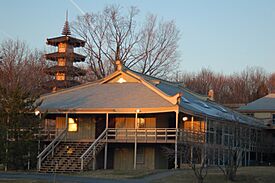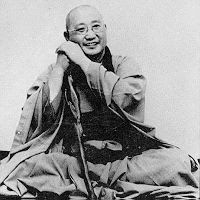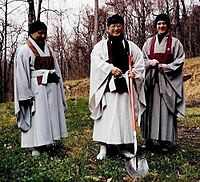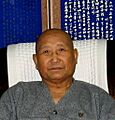Kwan Um School of Zen facts for kids
Quick facts for kids The Kwan Um School of Zen |
|
|---|---|

Providence Zen Center, the school's international headquarters
|
|
| School: | Korean Seon |
| Founder: | Zen Master Seung Sahn |
| Founded: | 1983 |
| Head temple: | Providence Zen Center |
| Guiding teacher: | Soeng Hyang |
| Regional Zen Master (Asia, Australia, Africa): | Dae Bong |
| Regional Zen Master (Americas): | Wu Kwang |
| Regional Zen Master (Europe): | Bon Shim |
| Head abbot: | Dae Kwang |
| Lineage: | Seung Sahn |
| Primary location: | International |
| Website: | www.kwanumzen.org/ |
The Kwan Um School of Zen (KUSZ) is a worldwide network of zen centers and groups. It was started in 1983 by a teacher named Zen Master Seung Sahn. The main center for the school is the Providence Zen Center in Cumberland, Rhode Island. This center was first opened in 1972.
The Kwan Um style of Zen practice mixes different Buddhist traditions. It includes rituals from Korean Buddhism and the Rinzai school of Zen. Their daily services also use ideas from Huayan and Pure Land Buddhism. Even though it's part of the Jogye Order of Korean Seon, Seung Sahn changed it to fit people in Western countries. Some say the Kwan Um School of Zen is the biggest Zen school in the Western world.
Contents
History of the Kwan Um School of Zen
Zen Master Seung Sahn first came to the United States in 1972. He lived in Providence, Rhode Island. To support himself, he worked at a Korean-owned laundromat, fixing washing machines. Soon, students from nearby Brown University started asking him for lessons. This led to the opening of the Providence Zen Center in 1972.
Early Zen Centers Founded by Seung Sahn
Before the school was officially created, Seung Sahn opened more centers.
- In 1974, he started the Dharma Zen Center in Los Angeles. This place was for regular people to practice Zen while living their normal lives. It welcomed everyone, no matter their background.
- The same year, the Cambridge Zen Center also began.
- In 1975, Seung Sahn founded the Chogye International Zen Center in New York City.
- Then, in 1977, Empty Gate Zen Center opened in Berkeley, California.
Growth and Official Founding of the School
In 1979, the Providence Zen Center moved to its current location in Cumberland, Rhode Island. The Kwan Um School of Zen was officially founded in 1983. In July of that year, work began on a Korean-style Zen monastery at the Providence Zen Center. The monastery officially opened in July 1984. By the summer of 1984, the school had four Zen centers and three groups in Poland. When Seung Sahn passed away in 2004, he had helped create almost 40 Zen centers around the world.
Zen in Israel: The Tel Aviv Zen Center
The Kwan Um School of Zen has one of its few centers in Israel. This is the Tel Aviv Zen Center, led by Revital Dan. There are four Kwan Um Zen centers in Israel. Their history is connected to Seung Sahn's visits to Israel in the 1990s. He taught at various alternative medicine places there. Revital Dan trained with Seung Sahn in Korea. When she returned to Israel, she started a Zen group. The Tel Aviv Zen Center opened in January 1999. The school's activities have been widely covered by the media, and more people are joining. The other three centers in Israel are the Hasharon Zen Center, the Ramat Gan Zen Group, and the Pardes Hanna Zen Centre.
What Makes Kwan Um Zen Unique?
The Kwan Um School combines different practices. It includes chanting the name of the bodhisattva of compassion. It also features energetic prostrations, which are common in Korean folk Buddhist practice. The school focuses on "together action." This means followers work together for the good of the community. Many members live in the Zen centers. One important rule is to put aside personal opinions for the group's benefit.
Meditation and Practice Methods
When Seung Sahn first came to America, his teachings were different from many Japanese Zen Masters. At first, he didn't focus much on seated meditation. This is a main part of most Japanese Zen traditions. Instead, he focused on Koans. Koans are riddles or stories used to help students understand Zen. Some of his first students had practiced in Japanese schools. They encouraged him to put more emphasis on sitting meditation.
Besides sitting meditation, chanting and prostrations are very important. These are forms of meditation meant to help clear the mind. The school's website explains that prostrations are a powerful way to clear the mind. They involve both the mind and body. Doing prostrations can help you understand things faster than just sitting meditation. Students often do 1000 bows a day (actually 1080). This can be done all at once or spread throughout the day. The number of prostrations depends on a person's physical ability. Usually, students do at least 108 and up to 1080 per day.
"Bodhisattva Monk" and Western Zen
Another unique thing in the Kwan Um School is that monks don't have to be celibate. Seung Sahn created the idea of a "Bodhisattva Monk." This is someone who can be married and have a job, but still be a monk. This role has now changed to "Bodhisattva Teacher." A Bodhisattva Teacher takes 48 special rules but is not considered an ordained monk.
Seung Sahn also had new ideas about Zen practice in Western culture. He was open to his dharma heirs (advanced students) starting their own schools. He believed that as more Zen Masters appeared, they would develop their own styles. He thought that Korean Zen might slowly change into American styles. He said that when Zen "marries" Western traditions like Christianity or Judaism, a new kind of Buddhism might appear. He encouraged everyone to create "American Buddhism."
Kyol Che: Intensive Retreats
During the summer and winter, the Kwan Um School of Zen offers Kyol Che. This means "tight dharma" and is an intensive silent meditation retreat. These retreats can last from 21 to 90 days. In Korea, both summer and winter Kyol Che last 90 days. The Providence Zen Center offers three weeks in summer and 90 days in winter. Shorter stays can be arranged for those with busy schedules.
A Kyol Che provides a structured environment for meditators. Taking part in these retreats helps people free themselves from too much thinking. It also helps them develop compassion. Participants have no contact with the outside world during the retreat. The only books allowed are those written by Seung Sahn. They practice from 4:45 a.m. to 9:45 p.m. each day. They are not allowed to keep a diary. Talking is only allowed when absolutely necessary. It is also allowed during dokusan, which is a private meeting with a teacher. The school also offers Yong Maeng Jong Jins. These are two- to seven-day silent retreats that include dokusan with a Ji Do Poep Sa Nim or Soen Sa Nim (Zen master).
Understanding the Zen Teacher Hierarchy
In the Kwan Um tradition, there are four main types of teachers. Each has reached a different level of understanding.
- Dharma Teacher: This person has taken the Ten Precepts. They have completed at least four years of training and eight weekend retreats. They understand basic Zen teachings. A Soen Sa Nim must confirm them to receive this title. They can give a Dharma talk but cannot answer questions from the audience.
- Senior Dharma Teacher: This is a Dharma teacher who, after at least five years, has been confirmed by a Soen Sa Nim. They have also taken the Sixteen precepts. They have more responsibility than a regular Dharma teacher. They can answer questions during talks and give private interviews.
- Ji Do Poep Sa Nim (JDPSN): This title means "dharma master." This person has completed kōan training and received inka. This means they are authorized to lead a retreat. Completing koan training is the first step. Then, a Zen Master must nominate them to receive inka. There's no single way to measure if someone has finished their koan training. Many students who pass all 12 Kwan Um "Gates" (koans) are not nominated for inka. Five Dharma teachers then assess the nominee. One is the nominating teacher, and four are independent. The nominee must show they are good at teaching and demonstrate their understanding in their daily life. If approved, a ceremony is held. The student then has a lively public Dharma combat with other students and teachers. They receive a kasa (robe) and keisaku (a stick used to encourage meditation). They then go through a period of teacher training.
- Soen Sa Nim: This title means "Zen master." A Soen Sa Nim is a JDPSN who has received full Dharma transmission from another master. This title is often used for Seung Sahn, but all Zen masters in the Kwan Um tradition hold this title.
An Abbot manages a Zen center. They handle things like budgets. They don't always provide spiritual guidance, though some Abbots are also Soen Sa Nims.
Important Zen Masters in the School
- School Guiding Teacher: Soeng Hyang
- School Abbot: Dae Kwang
Other Zen Masters:
- Dae Bong (Regional Zen Master, Asia, Australia, Africa)
- Bon Shim (Regional Zen Master, Europe)
- Wu Kwang (Regional Zen Master, Americas)
- Bon Yeon
- Su Bong (deceased)
- Wu Bong (deceased)
- Hae Kwang
- Bon Haeng
- Bon Soeng
- Dae Kwan
- Chong Gak Shim
- Dae Soen Haeng
- Ji Kwang
- Bon Hae
- Ji Haeng
Inactive Zen Masters:
- Sogong
New Schools Started by Kwan Um Teachers:
- Bomun (George Bowman)
- Dae Gak
- Ji Bong (Golden Wind Zen Order)
Images for kids
See also
- Korean Buddhism
- Buddhism in the United States
- Cambridge Zen Center
- Chogye International Zen Center
- Musangsa
- Tel Aviv Zen Center
- Timeline of Zen Buddhism in the United States
- The Compass of Zen
- Wonkwangsa International Zen Temple




















